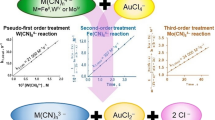Abstract
The reversible complexation of the pentaammine(pyridine-2-carboxylato)cobalt(III) ion [N5Co{O2C-(2)-C5H4 N}]2+ [N5=5HN3 and tetraethylenepentaammine (tetren)] with NiIIL(OH2)6-n [L=H2O (N5=tetren); L=bipy, ida2- (iminodiacetate) and nta3- (nitrilotriacetate), N5=5NH3 and tetren] has been investigated by the stopped-flow technique at 20-40 degC, and I= 0.3mol dm-3. At 25degC, the rate constants, kf(dm3 mol-1s-1), DeltaH(kJmol-1) and DeltaS(JK-1mol-1) for the formation of the ternary complexes [(tetren)-CoIII{O2C-(2)-C5H4N} NiIIL(OH2)6-n] are as follows: L=H2O, 530+9, 53+2, -15+7, respectively; L=bipy, 640+30, 37+3, -65+9; L=ida2-, 3900+100, 47+3, -18+11; L=nta3-, 10200+400, 49+1, −2+2. Nickel(II), in the ternary complexes, is chelated by the free pyridyl-N and the carboxylato moiety of the pyridine-2-carboxylate bound to the cobalt centre. The formation rate constant (kf) and the associated activation parameters are relatively insensitive to the N5 moieties for a given ligand L; kf increased in the order: Ni(OH2)62+Ni(bipy)(OH2)42+ Ni(ida)(OH2)3 (nta)(OH2)2-. Data analysis indicated that the mechanism shifted from the dissociative interchange (Id) to the chelation-controlled one, with the decrease of the available sites for coordination in NiIIL(OH2)6−n. The rate constants (kr) for the dissociation of [N5CoIII{O2C-(2)-C5 H4N}NiIIL(OH2) 6-(n+2)] to the parent reactants indicated steric acceleration [krL(5NH3) <krL(tetren)] and followed the trend: krNi(nta)->kr Ni(ida) >krNi(bipy)2+ for both pentaammine substrates. The chelate ring opening rate constants for the ternary complexes were estimated, from which it was apparent that the tetren envelope of cobalt(III) exerted relatively greater steric pressure as compared with 5NH3 in favouring opening up of the chelate ring.
Similar content being viewed by others
References
E.I. Solomon and Y. Zhang, Acc. Chem. Res., 25, 243 (1992); T. C. Bruice, Acc. Chem. Res., 24, 243 (1991); J. Chin, Acc. Chem. Res., 24, 145 (1991).
J. R. Roper and H. Ellias, Inorg. Chem. 31, 1202 (1992).
D. N. Hague and A. R. White, J. Chem. Soc., Dalton Trans., 1337 (1993).
J. Arpalahti, M. Mikola and S. Mauristo, Inorg. Chem., 32, 3327 (1993).
S. P. Dagnall, D. N. Hague, J. S. Henshaw and A. D. Moreton, J. Chem. Soc., Dalton Trans., 867 (1996).
D. N. Hague and A. R. White, J. Chem. Soc., Dalton Trans., 3645 (1994).
A. C. Dash, A. N. Acharya and R. K. Sahoo, J. Chem. Soc., Dalton Trans., 3727 (1994).
I. Fabian, Inorg. Chem., 32, 1184 (1993).
D. W. Margerum, G. R. Cayley, D. C., Weatherburn and G. K. Pagenkopf, ACS Monogr. 1978, Vol. 2, Ch. 1.
E. C. Constable, Adv. Inorg. Chem., 34, 1 (1989).
A. C. Dash and S. Das, J. Chem. Res., (S) 136; (M) 0925 (1997).
A. C. Dash, M. S. Dash and S. K. Mohapatra, J. Inorg. Nucl. Chem., 43, 1074 (1981).
E. S. Gould and H. Taube, J. Am. Chem. Soc., 86, 1318 (1964).
A. I. Vogel, A Text Book of Quantitative Inorganic Analysis, 3rd Edit., ELBS and Longman, London, 1962, p. 435.
A. C. Dash and R. K. Nanda, Inorg. Chem., 12, 2024 (1973).
D. D. Perrin and B. Dempsy (Eds.) Buffers for pH and Metal ion control, Chapman & Hall, London, 1974.
C. W. Davies, Ion Association, Butterworths, London, 1962, p. 39.
A. E. Martell and R. M. Smith (Eds.), Critical Stability Constants, Plenum, New York, 1974, Vol. 1, p. 118, 141; Vol. 2, p. 235.
A.C. Dash, R. K. Nanda and A. N. Acharya, J. Chem. Soc., Dalton Trans., 1023 (1993).
A. E. Martell and R. J. Motekaitis, Determination and use of Stability Constants, 2nd Edit., VCH, Weinheim, 1992, Ch. 4.
N. Das and A. C. Dash, Indian J. Chem., 32A, 531 (1993).
M. D. Johnson and R. J. Balahura, Inorg. Chem., 31, 1832 (1992).
R. M. Fuoss, J. Am. Chem. Soc., 80, 5054 (1958).
C. T. Lin and D. B. Rorabacher, Inorg. Chem., 12, 1498 (1973).
T. S. Swift, R. E. Connick and D. Fiat, J. Chem. Phys., 37, 307 (1962).
A. G. Desai, H. W. Dodgen and J. P. Hunt, J. Am. Chem. Soc., 92, 798 (1970).
J. Neely and R. E. Connick, J. Am. Chem. Soc., 92, 3476 (1970).
M. Grant, H. W. Dodgen and J. P. Hunt, J. Am. Chem. Soc., 92, 5001 (1970).
Ref. 9, p. 124.
Author information
Authors and Affiliations
Rights and permissions
About this article
Cite this article
Acharya, A.N., Dash, A.C. & Das, S. Kinetics and mechanism of the interaction of pentaammine(pyridine-2-carboxylato)cobalt(III) ions with hexaaquanickel(II) and nickel(II) complexes: the role of chelating ligands. Transition Metal Chemistry 23, 175–181 (1998). https://doi.org/10.1023/A:1006907428953
Issue Date:
DOI: https://doi.org/10.1023/A:1006907428953



